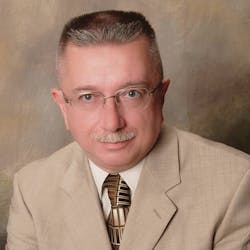According to the National Number Association, 80 percent or more of the nation’s 240 million annual 9-1-1 calls come from cell phones. These devices are now common, but that wasn’t always the case. In the mid-1990s, the fire service added a tool to their arsenal with the deployment of wireless 9-1-1. Unfortunately, this tool turned out to be a double-edged sword. Accidents on limited-access highways and fires in remote areas were now reported more quickly, eliminating the delay caused by having to search for a pay phone. And, as we all know, seconds count in any true emergency.
Although timely reporting was certainly a huge benefit, there were aspects of cellular telephony that proved problematic. For starters, the enhanced feature of 9-1-1 that we relied upon for years to provide a location wasn’t initially there. That’s because telephones were no longer in a fixed place. Instead of being connected to the network by a piece of wire that never moved, they were now free to travel. And travel they did! As a result, dispatchers found themselves asking numerous questions in order to determine where the problem was. Since the caller could be from anywhere and not just a local resident, the tried-and-true method of using historical landmarks no longer worked. Folks from the city had no clue as to where Farmer Jones wrecked his tractor years ago.
In 1996, the Federal Communications Commission (FCC) addressed the matter with Report and Order 94-102, albeit by taking a technology agnostic approach. Incremental improvements were made from having no location information, to identification of the cell site receiving the call to providing an approximate whereabouts. To paraphrase the requirements, most reports had to be identified as coming from an area the size of several football fields. Since a majority is not all, this was more beneficial in the country than it was in the city where a number of streets and buildings could easily fall within the specified perimeter.
Added to this reality was that locations were now being received based upon latitude and longitude rather than by conventional addresses, requiring that dispatch center maps be digitally accurate, and that some form of translation take place. Sending the troops to 40.7484° North, 73.9857° West wasn’t feasible, but responders know where the Empire State Building is. These coordinates equate to 34th Street and 5th Avenue, a more familiar address for this New York City landmark.
Since the original FCC filing, there have been a number of additional legal actions, including the requirement to report the so-called “Z coordinate” of elevation by the deadline of 2026. Again, similar to the differences between conventional and wireless E 9-1-1, since the calling device is no longer fixed to an office or apartment on an identified floor, the height value will be somewhat approximate. This is obviously critical in multi-story structures. However, any improvements are vital since there has been a 60-fold increase in cellphones worldwide since 1996, and they are now the driving force in emergency reporting.
Some new tricks
In 2021, the CTIA, a Washington, DC-based communications trade association, touted recent accuracy statistics in this release, claiming that 80 percent of 9-1-1 calls could be plotted within a 50-meter radius. Besides work done to the carrier networks, third parties have been instrumental in improving location technology. One such company is RapidSOS who use satellite tracking to enhance location information provided to call takers. This provides greatly improved data in real time compared to conventional methods alone.
Mark Fletcher, ENP (Emergency Number Professional), is vice president of public safety solutions at 911inform LLC, a firm specializing in providing cross-platform data such as detailed building maps, security cameras, access control, facial recognition, and even gunshot detection to first responders. He offered his take on the current state of the art.
“Legacy 9-1-1 is based on a phone number representing a location,” he says. “Phone numbers have become highly mobile, and therefore are no longer reliable indicators for location purposes. The natural response was to go to zones that represented a specific square footage, but every building is like a snowflake, and no two are the same. Because of this square footage is also an inadequate indicator for location, as it depends on the number of egress and ingress points to the area, the population of the area, the use of the area, and in the case of a fire, hazardous materials that may exist in the area.
“The fix for this is to move away from phone numbers and area reporting. Today, that can be delivered over the top through the RapidSOS architecture. Whether it's handset-based location from cellular phones, or real-time enterprise data from solutions like 911inform, it allows the conveyance of that information.
“In reality, we're trying to make an old dog perform new tricks that it's just not capable of doing. In that case, it's time to take the old dog off of life-support.”
The “old dog” referred to by Fletcher is our existing 9-1-1 system, the core of which was designed in an analog age, and first came on line almost 55 years ago. With apparatus being retired in half that time, there is precious little mechanically active in the fire service for such a duration. While incremental updates have been made in an effort to accommodate the burgeoning wave of digital devices, the truth is that these measures have been little more than patches, and the core technology is rapidly approaching end of life, if not already past. To that end, the next generation of 9-1-1, or NG911, is being currently deployed. However, since this involves an almost wholesale replacement of both dispatch center equipment and networks nationwide, the change will not happen overnight.
Aside from more familiar types of location identification, such as street address and latitude/longitude, a relatively new method has entered the scene. What3words has addressed every nine-square meter of the globe with unique 3-word combinations. For example, the aforementioned corner of 34th Street and Fifth Avenue in New York City is represented by the phrase “curiosity.firm.monks.” Certainly, in stark contrast to the familiar, this method rose in popularity overseas, but has made inroads here in the United States, with several public safety agencies having already made use of its extreme accuracy. What3words can be coupled with RapidSOS, and some successful examples of this integration can be found here.
Improving
Perhaps no piece of information is more critical in the early stages of response than having a good location. With continuing FCC actions, improvements to the 9-1-1 network, and third-party applications that greatly improve accuracy, the chances of quickly obtaining that data may not be a currently guaranteed reality, but they are nonetheless increasing every day.
About the Author

Barry Furey
BARRY FUREY, who is a Firehouse Contributing Editor, provides consulting and training services in emergency communications. He is the former director of the Raleigh-Wake Emergency Communications Center in North Carolina. During his 50-year public safety career, he has managed 9-1-1 centers and served as a volunteer fire officer in three other states. In 2005, Furey received a life membership in the Association of Public-Safety Communications Officials (APCO) International for his continued work in emergency communications. Furey was inducted into the Firehouse Hall of Fame in 2017.
